The author believes there are no previous in-depth examination of the two temporary sand-bag gun batteries constructed at Point Nepean during 1878-1882. Utilizing contemporary newspaper descriptions and five 1882 Fort Nepean drawings from the Australian National Archives collection, this article provides a comprehensive description of these two significant 19th Century defence works.
In 1876 the combined Australian colonies requested that Imperial authorities send Major-General Sir William Jervois to advise them on defence needs. In July 1877 a ‘Preliminary Report on Defences – Victoria’ was produced by Sir William and Colonel Peter Scratchley for the Victorian Parliament. (i) The scheme was based on the same principles as those they had previously recommended for the defence of Port Jackson. Jervois and Scratchley advised the ‘stand against the enemy should be made at the Heads to exclude ingress to the inner harbours.’
At Port Phillip the entrance was to have three ‘torpedo’ defence zones, each consisting of four lines of electrically discharged observation ground mines and buoyant mines, and two lines of electro-contact mines placed in front. This would defend the three navigable channels; the whole being under fire of several gun battery earthworks, so as to prevent any attempts to remove, or countermine, the torpedo fields. The land defences would rest on the northern shore with an enlarged Shortland’s Bluff Battery at Queenscliff and on the southern shore, two new batteries to be constructed on Point Nepean.
Jervois had recommended purchase of the heaviest British ordnance then available – 11-inch 25-ton RML guns. However, as there would have been considerable delays in ordnance manufacture and supply, it was decided to expand the existing battery on Shortland’s Bluff with three of the six 9-inch 12-ton RML guns already in the colony. They were to be sited in a temporary battery located west of the existing work. The existing 68-pdr armament was to be replaced by four Armstrong 80-pdr RML guns. These seven ‘Queenscliff’ guns would then cross-fire with four 80-pdr’s to be located in a temporary emplacement on the headland knoll at Point Nepean. During Easter 1878 a revetment battery for three 9-inch RML’s was constructed at the western end of Shortland’s Bluff by Victoria’s Garrison Artillery and sapper engineers assisted by the local Volunteer Company. An earthwork revetment was constructed from limestone rubble obtained from a forward dry ditch and then lined with sandbags on the interior face. The battery was entirely open at the rear.
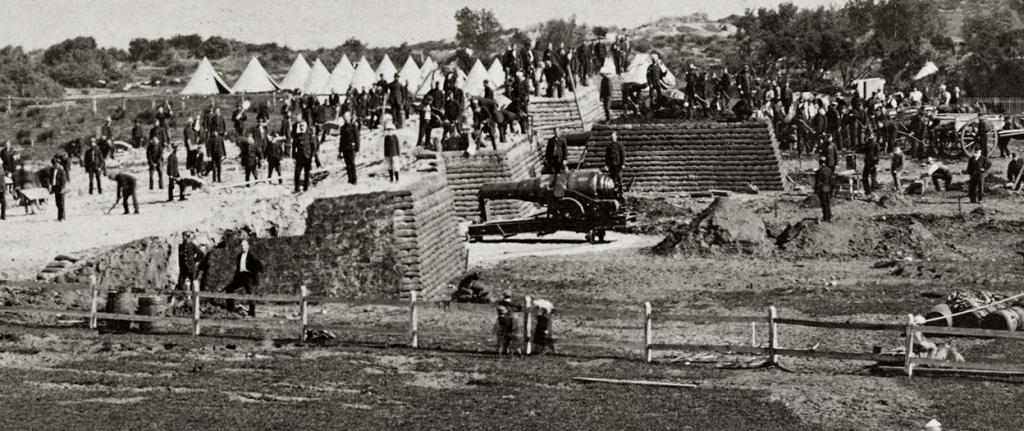
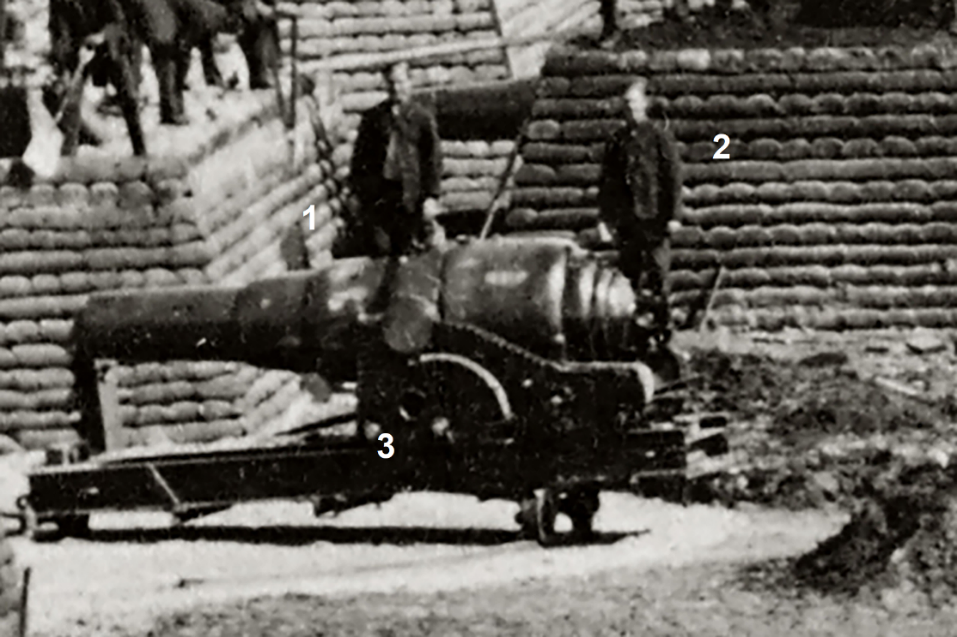
On the Nepean side work commenced in mid-June 1878 – again utilizing the Queenscliff Garrison Artillery, who made a daily voyage by government boat to the Quarantine Station Pier. The placing of the P&O Mail steamer ‘Siam’ into quarantine on June 25 (with 3 suspected cases of smallpox aboard) immediately closed this point of access. There was no existing jetty at the Nepean site so a wooden house was erected near the works for accommodation and the Public Works department had a road surveyed from the Quarantine Station to Point Nepean while calling for tenders to erect a jetty at the latter place, so as to enable boats to land passengers and stores at any time.(iii) Almost 9,000 sandbags were brought ashore along with the four guns, timber gun platforms, and iron racers.(iv)
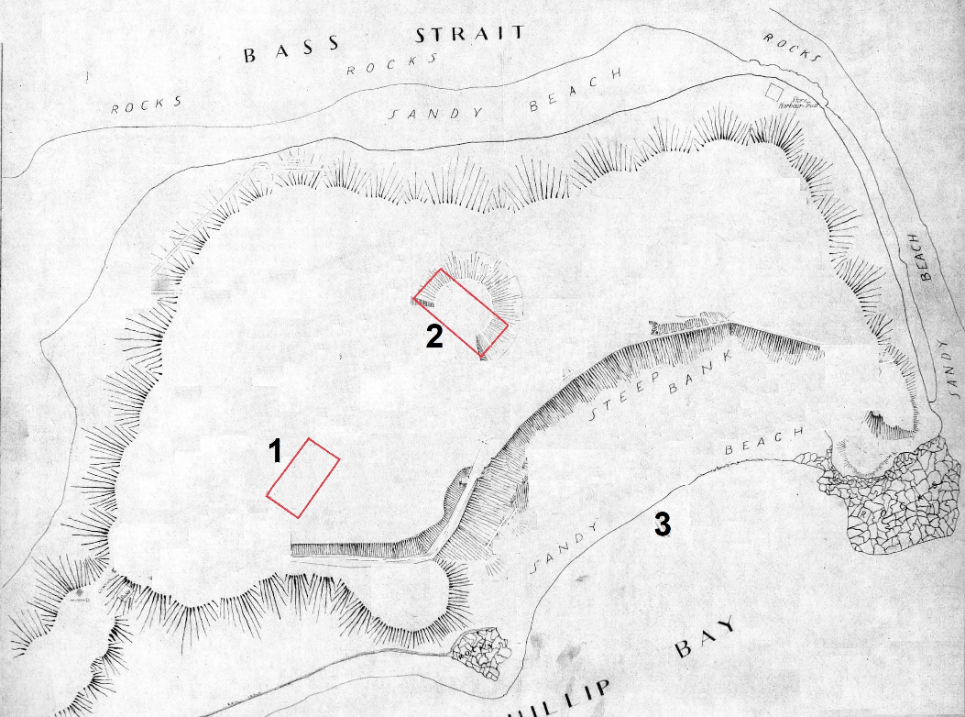
1 – The Channel Battery 2 – The Entrance Battery 3 – Landing Beach
‘The first battery was known as No 1, or the channel battery, and is for the defence of the channel and the fairway, should hostile ships effect an entrance through the Heads. It is placed about midway of the cove, just inside the Point, and mounts two 80 pounder Armstrong guns, which are placed 60-ft apart, at an elevation of 100-ft above low water mark The guns have a range of 120-deg to the right from the Point, or as far as the flagstaff at the quarantine ground.(v) They also command the cove at the opposite side of the entrance, between Point Lonsdale and Queenscliff, thereby preventing a landing being attempted to gain the rear of the Queenscliff batteries. This Work is sunk in the ground to a depth of 4-ft 3in, the muzzles of the guns just appearing on the ground line. By this plan the whole of the battery is protected by the depth of the excavation and the parapets, which are carried up about 7-ft 3in in height, the gun firing through an opening or embrasure. Thus ample protection is given to the men and guns. Between the guns is placed a chamber of great strength, made of blue gum timber, for filling projectiles. This is sunk another 4-ft, in order that the chamber may be below the ground line, and to further strengthen it there is also 8-ft of earth on top, and 10-ft in front. In the parapet is placed a lookout where the officer in charge of the battery can observe the effects of the fire from the guns without exposure. The flanks of the battery are also protected by parapets, as well as the rear, the interior being gained by ramps from each end, while access to the rear is gained by steps. The ground in front of the guns is sloped sufficiently to command the beach, where a boat attack might be attempted. In rear of the right flank of the work, a parapet has been made to protect the rear of the battery from seaward, and also to cover the communication (where exposed) between the batteries. On the low ground, undercover of the hills where the communication is carried, a flagstaff has been erected for signalling purposes.’ (vi)
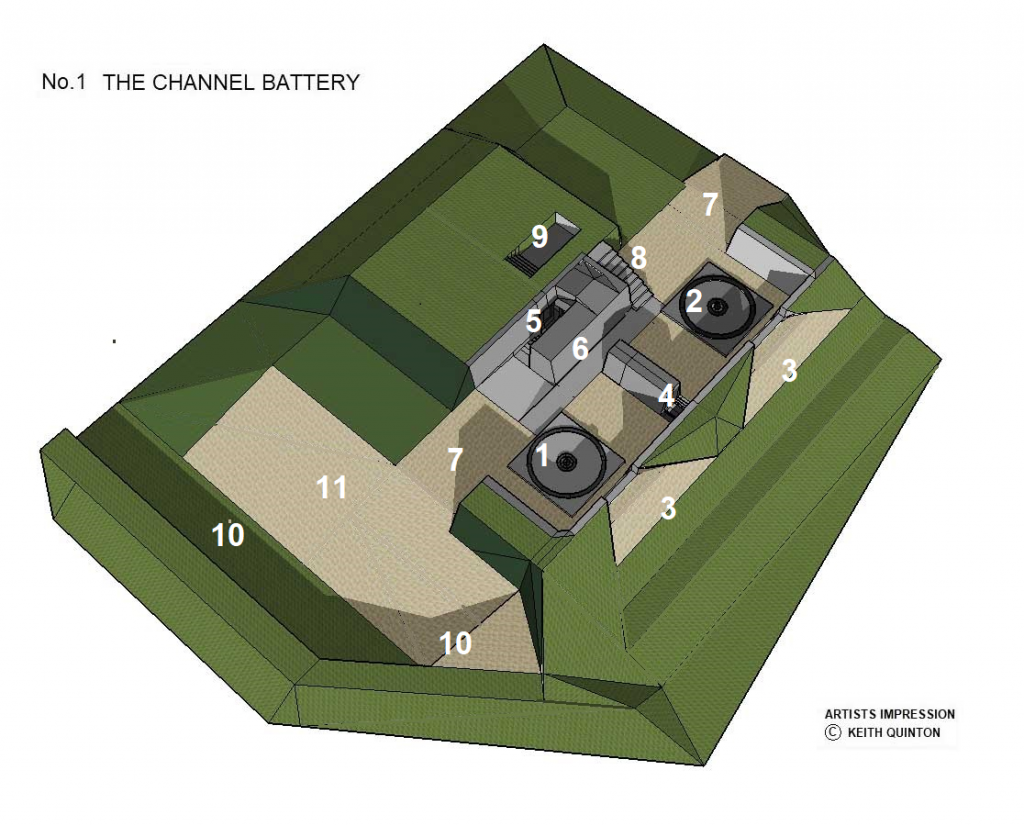
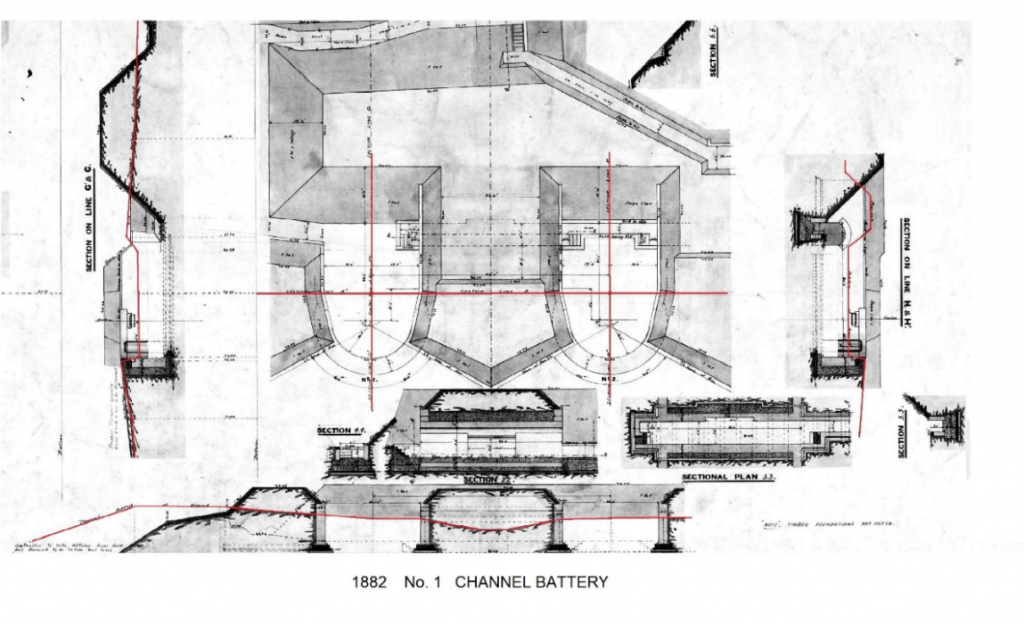
‘The other battery (No 2) is placed nearer to and across the Point, being nearly at right angles with the direction of the land. This also mounts two 80 pounder Armstrong guns, and is somewhat similar to the other work, except the parapets, which are corned up all round the battery. The guns have a range of 150-deg from the Barwon Heads to the right, or up the fairway of the South Channel. They can also if desired, fire seaward to protect the rear of No 1 battery and its own. The guns command the coves or beach between Barwon Heads and Point Lonsdale, also to Queenscliff.’
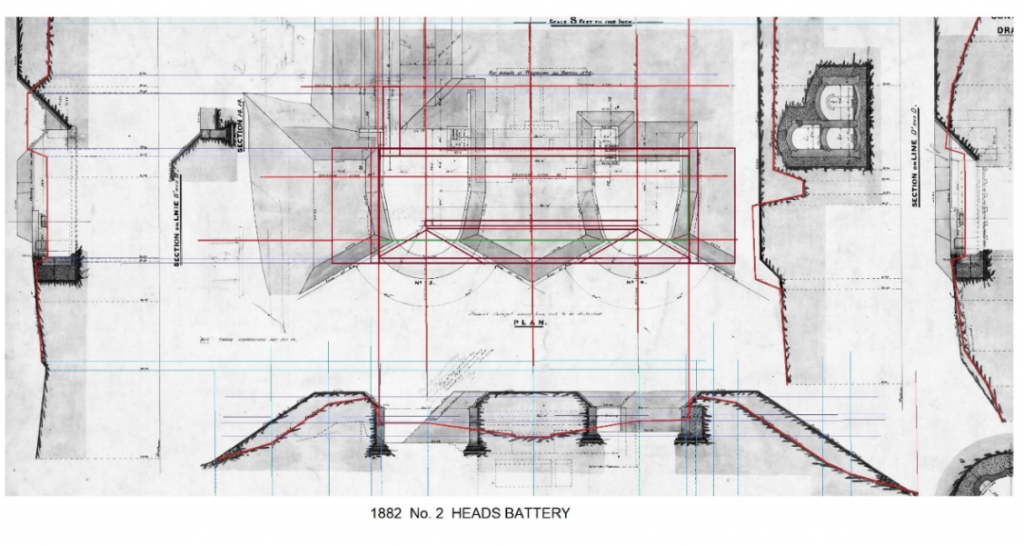
The approach to No 2 battery is through a cutting (the only entrance), as the work is more exposed. To obtain the site of this battery – a most commanding position – over 1,000 yards of sand had to be removed, the original site being a sand ridge of about 4ft in width. The ground in front of the guns and interior of the battery is covered with limestone brought up from the beach, and the face of the work is covered with scrub, grasses, & c. The cultivation of the scrub is most important, and a large quantity of seed and plants of the native scrub has been planted as directed by Baron Von Mueller.’ (vii)
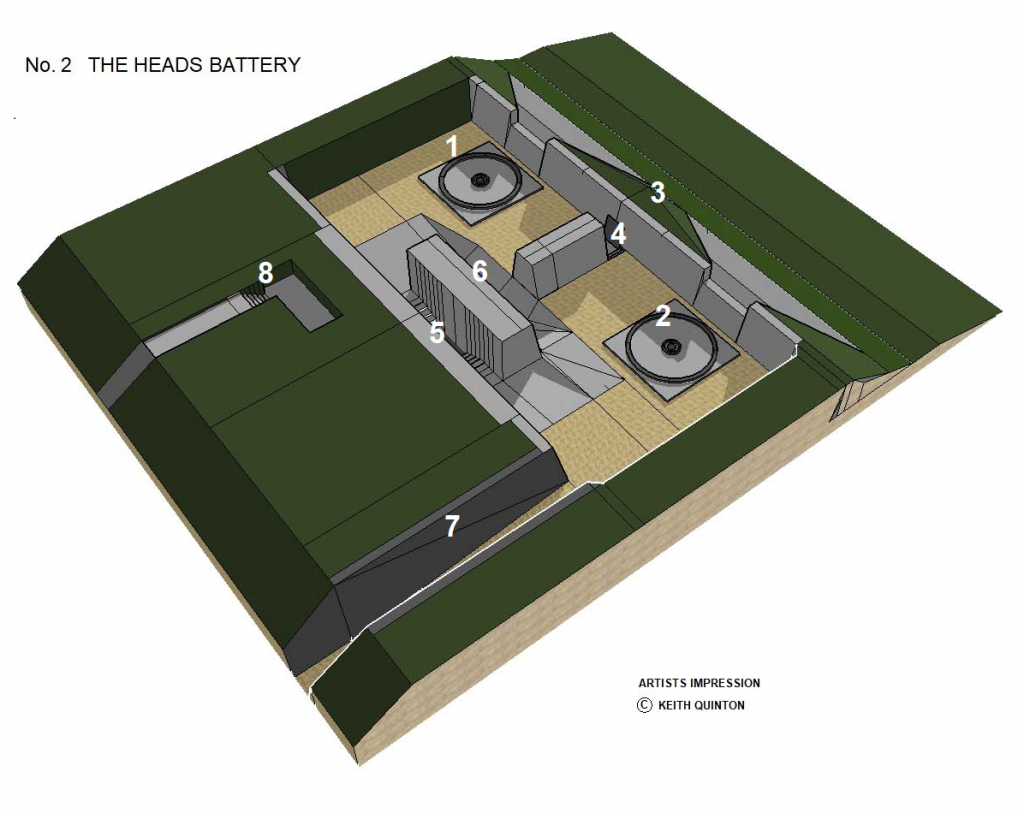
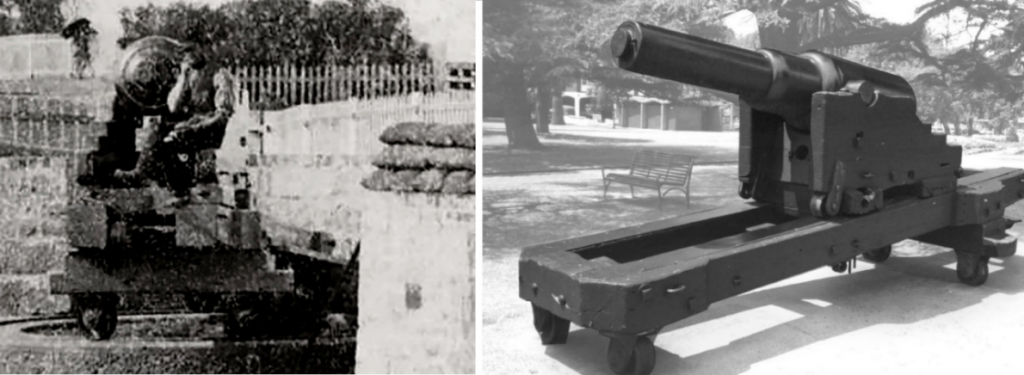
‘The works, though called temporary, and erected pending the construction of the permanent works, are solidly made, the walls being built of tarred sand bags about 2-ft thick against which the parapets are built and with a little expenditure for tar, &c, will last some time. The guns are mounted on wood platforms made of segments of red gum blocks on a foundation of kauri timber, in all 2-ft thick they are similar to the stone platform with circular racers at Queenscliff, wood kerbs being substituted for stone to construct the works, three detachments of the Victorian Artillery corps have been employed -26 men, one month each – including hauling stores, mounting guns, &c. ’(viii)
During the parliamentary sitting of June 1882 Mr Langridge as Commissioner of Public Works reported he did not know of any general feeling that the colony should rush into further expenditure on the Heads defences. ‘At Queenscliff we had an excellent battery, well mounted, and another mounted with four guns at Point Nepean. The latter was somewhat out of repair but could be made of great service at a small cost. He did not approve of rushing into any large expenditure, but held that the works at present in progress should be perfected.’(ix)
In September 1882 a contract was let for the construction of the permanent Point Nepean battery at a cost of £11,400, with the drawings produced by John Blackbourn,(x) recently employed as Victorian assistant defence engineer to Colonel Scratchley – who departed for England in January 1883 at the completion of his 5-year appointment as Australian Colonial Defence Advisor. By August 1883, £4,000 has already been spent. An additional sum of about £15,500 was eventually required, making a total cost for the new Nepean battery works of £26,900.
(i) Preliminary Report on Defences – Victoria
(ii) Victorian Forts & Artillery
(iii) Australasian (Melbourne) Saturday 25 May 1878. ‘Town News’ Page 19 Argus Saturday 1 June 1878 ‘Volunteer News’ page 5 Age Saturday 1 June 1878 ‘ Smallpox on board the Siam’ Page 5
(iv) Point Nepean Forts Conservation Management Plan – Parks Victoria. 2006 Page 20 General History – Louise Honman 1990 – Victorian Year Book 1880-81 p.12 and Reserve Branch Files Summary of Works at Point Nepean; Australian Archives B.3712 Folder 14; Contracts Reserve Branch Files. Summary of works. See also PWD Contracts 81.2/125.
(v) While the new 9-inch guns at Queenscliff Lower Battery were emplaced with ‘A’ pivot racers (70⁰) it is likely the Nepean 80-pdr guns were mounted on ‘C’ pivot racers to provide a greater sweep of fire – 120⁰ arc – across the Heads entrance zone.
The A & B pivot usually give a field of fire of 70⁰. The C pivot gives 360⁰, whilst the D gives 180⁰ or 360⁰. The E & F pivots give 180⁰. ‘A’ pivots are suitable for embrasures; ‘D’ pivots for barbette emplacements with less than 140⁰ of lateral training and ‘C’ pivots for barbettes with a larger amount. Casemate slides are used only with ‘A’ pivot racers. Dwarf slides are suited to all pivots. ‘D’ pivots were not much used except for the colonial carriage. ‘E’ & ‘F’ pivots were specially designed for the tops of Martello towers and are rarely found elsewhere. In ‘C’ and ‘D’ pivots the actual pivot is usually an old gun, a 24 or 32 pr. S.B. set in concrete. An alternative is a cast iron pivot block.
https://www.victorianforts.co.uk/art/empl/emp1.htm
(vi) The Argus The New Batteries at Point Nepean 24 September 1878 Page 7
(vii) ibid
(viii) Ibid
(ix) Argus (Melbourne, Vic. : 1848 – 1957), Wednesday 28 June 1882, page 4
(x) The Life and Times of John Blackbourn C.E. – Victoria’s Defence Engineer. (1842-1911) Keith Quinton. Blurb Books USA. 2020
Click here for Fort Nepean – Understanding the trace – Part 2: The Point Nepean Batteries 1882-1885
Contact Keith Quinton about this article.






